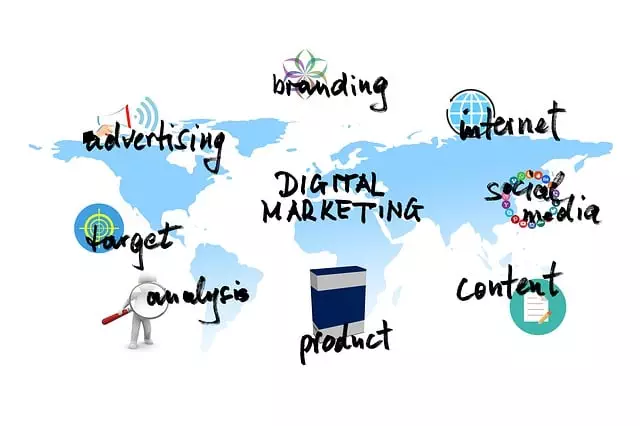In today's digital era, Social Media Marketing (SMM) is a crucial component of digital marketing strategies. Businesses utilize platforms like Facebook, Instagram, Twitter, LinkedIn, and TikTok for brand awareness, engagement, and conversions. Key steps include defining target audiences through market research and analytics, selecting appropriate platforms based on audience preferences, creating compelling content, leveraging hashtags, influencers, and paid advertising, measuring success via KPIs, and actively engaging with the community to build relationships and foster loyalty. Effective SMM optimization contributes significantly to overall digital marketing success.
In the dynamic landscape of digital marketing, social media platforms have evolved from casual connections to powerful tools for business growth. This article explores the essence of Social Media Marketing in the digital age, providing insights into strategic planning and execution. From defining your target audience to leveraging hashtags and influencers, each section uncovers crucial elements for success. Learn how to create compelling content, measure key performance indicators (KPIs), build community engagement, and harness analytics for informed decision-making in today’s competitive market.
Understanding Social Media Marketing in the Digital Age

In the digital age, Social Media Marketing (SMM) has emerged as a powerful tool for businesses to connect with their audience and promote their products or services. It transcends traditional marketing boundaries by leveraging online platforms like Facebook, Instagram, Twitter, LinkedIn, and TikTok to create engaging content that fosters interaction and builds brand awareness. SMM is not just about posting updates; it involves strategic planning, understanding analytics, and creating a narrative that resonates with the target demographic in a visually captivating and shareable manner.
Digital Marketing, as an umbrella term, encompasses various strategies, but SMM stands out for its ability to provide real-time insights into consumer behavior, preferences, and trends. Marketers can use these data points to refine their campaigns, improve customer engagement, and drive conversions more effectively than ever before. With the constant evolution of social media platforms, staying agile and adapting marketing strategies accordingly is crucial to staying relevant in today’s fast-paced digital landscape.
Defining Your Target Audience for Effective Strategies

Defining your target audience is a cornerstone in crafting effective social media marketing strategies within the digital marketing landscape. Understanding who your ideal customers are, their demographics, interests, behaviors, and pain points allows for tailored content creation and ad placements. By segmenting your audience, you can ensure that your messages resonate with those most likely to engage, convert, and advocate for your brand.
This process involves gathering data through market research, analyzing existing customer insights, and leveraging social media analytics tools. It’s not just about age and gender; it delves into psychographics, online behaviors, and preferences. This level of understanding enables you to create compelling content that speaks directly to your audience’s needs and aspirations, fostering genuine connections and driving tangible results in your digital marketing efforts.
Choosing the Right Platforms to Reach Your Market

When it comes to crafting a successful social media marketing strategy, selecting the right platforms is akin to finding the key to unlocking a treasure chest. Each platform caters to unique audiences and offers distinct advantages, making it imperative for businesses to align their choices with their target market. For instance, Instagram resonates with visual storytelling, ideal for showcasing products or brands with an artistic flair. In contrast, LinkedIn is the go-to for B2B connections and professional networking, emphasizing industry insights and thought leadership.
In the realm of digital marketing, understanding your audience’s habits and preferences is crucial. Twitter, with its real-time conversations, is perfect for quick updates and engaging with customers directly. Facebook, on the other hand, allows for more in-depth interactions and content variety, from text posts to live videos. By carefully considering these options and tailoring content accordingly, businesses can ensure their messages resonate with the right audiences, fostering engagement and ultimately driving sales.
Creating Compelling Content that Engages and Converts

In the realm of digital marketing, creating compelling content is an art that captivates audiences and drives conversions. Going beyond mere promotion, engaging content tells a story, fosters connections, and leaves a lasting impression. It involves understanding your target audience’s needs, interests, and pain points to deliver valuable information, entertainment, or solutions in a unique and memorable way. This might include interactive videos, thought-provoking blog posts, captivating infographics, or creative visuals that spark conversations and encourage sharing.
By integrating these elements effectively into your social media strategy, you can enhance user engagement, build brand loyalty, and ultimately convert interested followers into paying customers. Remember, in the fast-paced world of social media, content that stands out, provokes emotions, or offers a new perspective is more likely to be noticed, shared, and remembered—ultimately contributing to your overall marketing success within the digital landscape.
Utilizing Hashtags, Influencers, and Paid Advertising

In the realm of digital marketing, social media platforms offer a powerful toolkit for brands to enhance their reach and engagement. Utilizing hashtags effectively can amplify the visibility of content by categorizing it within specific topics, making it easier for target audiences to discover. Influencers play a pivotal role in driving brand awareness and credibility; their endorsements carry significant weight as they vouch for products or services to their dedicated followers.
Paid advertising on social media platforms allows businesses to reach precise audiences based on demographics, interests, and behaviors, ensuring that marketing efforts are cost-efficient and yield better returns. This strategic combination of hashtags, influencers, and paid ads can significantly boost the impact of social media marketing campaigns in today’s digital landscape.
Measuring Success: Analytics and Key Performance Indicators (KPIs)

In the realm of digital marketing, measuring success is paramount for any social media strategy. Analytics and Key Performance Indicators (KPIs) serve as compasses, guiding businesses to assess the effectiveness of their campaigns and tailor future efforts accordingly. By leveraging data-driven insights, marketers can uncover what resonates with audiences and what doesn’t, optimizing engagement and return on investment.
Popular KPIs in social media marketing include reach, engagement rate, click-through rates (CTR), conversions, and cost per acquisition. Reach tells the story of how many unique users encounter your content; engagement rate measures the level of interaction, such as likes, comments, or shares; CTR gauges the effectiveness of calls to action; conversions track desired actions like sign-ups or sales; and cost per acquisition highlights the price paid for each new customer acquired through social media channels.
Building Relationships and Fostering Community Engagement

In the realm of digital marketing, building relationships and fostering community engagement are pivotal strategies for success. Social media platforms offer a unique opportunity to connect with audiences on a more personal level, allowing businesses to create meaningful interactions that extend beyond mere transactions. By engaging in conversations, responding to comments, and sharing valuable content, brands can establish themselves as trusted entities within their communities. This two-way communication fosters a sense of belonging and encourages users to become advocates for the brand, amplifying its reach and influence.
Community engagement goes beyond individual interactions; it involves creating a vibrant online space where like-minded individuals gather, share experiences, and support one another. Marketers can facilitate this by curating content that resonates with their target audience’s interests and values. Through contests, polls, and user-generated content campaigns, businesses can tap into the collective energy of their followers, fostering a sense of ownership and loyalty. This organic engagement not only strengthens brand visibility but also contributes to building a dedicated community that drives long-term success in digital marketing efforts.
